 Category: Virginia Wineries
Category: Virginia Wineries
Just off the Grape Press: New Editors
It’s a pleasure to announce that the Vineyard Goddess and I are now co-editors of Grape Press, the quarterly publication of the Virginia Vineyards Association. Our first issue is the just-published Spring 2013 edition, and while we took over editorial responsibilities too late to have had any role in the planning, we spent lots of time collecting articles, working with the authors on final edits, revamping the look of page 1, and dealing with the hundreds (well, dozens and dozens) of little details that come up as you’re going to press.
We’re very excited about this opportunity for a number of reasons. First, lots of folks in the Virginia viticulture community have been 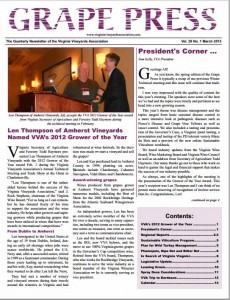 very generous with us, giving hours of their time to assist in our education. Early on, for example, I posted a note to a web site for the Central Virginia Winemakers group asking a question about how much time I should expect to set aside to manage a small vineyard I got lots of responses, and two of the folks who replied to my query hosted us at their vineyard for what amounted to a seminar on growing grapes.
very generous with us, giving hours of their time to assist in our education. Early on, for example, I posted a note to a web site for the Central Virginia Winemakers group asking a question about how much time I should expect to set aside to manage a small vineyard I got lots of responses, and two of the folks who replied to my query hosted us at their vineyard for what amounted to a seminar on growing grapes.
Secondly, we’re big fans of Virginia wine. We attended our first Virginia wine festival some 25 years ago, and while the wines weren’t great back then, some were pretty good, and we thought they all had promise. We were right. The wines got better each year, and today, we think Virginia wines have really come into their own. Virginia Viognier is a world-class wine. Cab Franc, Merlot, Petit Verdot, Petit Manseng, Norton and a number of other grape varieties have been made into truly great wines. My personal view is that a number of the Commonwealth’s wineries are making wines that can compete anywhere in the world, and their ranks are growing each year.
A major reason for the continued improvement in Virginia wine is the quality of the fruit that wineries have to work with. As the old saying goes, wine is made in the vineyard. And the quality of the fruit is improving in no small part because of the willingness of so many in the business to help each other out. In this industry, people share knowledge. Grape Press is part of that process, and the Vineyard Goddess and I are thrilled to be able to play a part, however small, in the continued growth of the Virginia wine industry
As I said, we can’t take credit for the range of high-quality stories in the current edition, but we did have a chance to work with the authors, and it was one of the best journalistic experiences of my life. The writers were all involved in one aspect or another of viticulture, from the distinguished vineyard consultant Lucie Morton to grape pathologist Mizuho Nita to Ankida Ridge vineyard owner Christine Vrooman.
The writers were knowledgeable and intelligent, and their articles were infused with personality and wit, which made them a pleasure to read. I won’t try to mention everything from this issue, but Christine Vrooman’s series on sustainability, Andrew Hodson’s article comparing French and Virginia Viognier, and Jim Benefiel’s story on a VVA expedition to Bordeaux are among those I would recommend to anyone. And honestly, there isn’t a bad article in the whole issue. Bill Freitag, Katie Hellebush, Pete Johns, Lucie Morton, Mizuho Nita and Dean Triplett contributed excellent articles, and they’re all worth a read. For what it’s worth, I read the entire issue, word for word, at least twice, and I enjoyed it as much on the final read as I did on the first round of edits.
Membership in the Virginia Vineyards Association is a must for anyone involved in the Virginia wine industry. But Grape Press is great resource for anyone interested in viticulture, no matter where you live. It’s a great publication, and Chris (the Vineyard Goddess) and I will be doing our very best to ensure hat it continues to be great.
Five Vintages of Cab Franc at Gadino Cellars
As I’ve said before, I believe that Cabernet Franc is Virginia’s signature red grape, even if Petit Verdot iscoming on strong. It is more cold-hardy than Merlot or Cabernet Sauvignon, and it ripens earlier. That’s important in Virginia, which can be prone to early frost, Fall rains, and the occasional harsh winter. And Cab Franc is a wonderful grape on its own. It has softer tannins than Cab Sauv, and while it might not be quite as age-worthy, wines today are being made (and
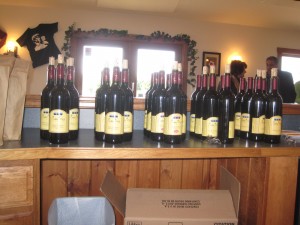
- Five Vintages of Cab Franc waiting to be poured, along with a mystery wine, hidden in brown bags for blind tasting
purchased) for early drinking, not for years in the cellar. Cab Franc will age, of course, but it is also more accessible when young than the more tannic reds. And Cab Franc can be used on its own or as a blend to make wines with great complexity, as the great St. Emilion blend, Cheval Blanc, demonstrates.
Cab Frank is particularly important to my wife, the Vineyard Goddess, and me, because it’s one of three grapes we will be planting this Spring, the other two being Petit Verdot and Viognier. (We had hoped to plant Petit Manseng as well, but couldn’t find the certified vines we wanted.)
So, I was thrilled to have the opportunity Saturday to participate in a vertical tasting of Cab Francs at Gadino Cellars in Washington, VA (Rappahannock County). We tasted wines from 2005, 2006, 2007, 2008, and 2009, plus a barrel sample of the 2011. The Gadinos threw in a mystery wine, which we tasted blind. More on the mystery wine later. Continue Reading–>
The Year of the Sorting Table
Following up on my last blog, which concerned Cab Franc, Tim Mondavi, and the 2011 vintage in Virginia, among other things, I just read Emily Pelton’s article on the 2011 harvest in Grape Press, the publication of the Virginia Vineyards Association, and I am somewhat more hopeful about this vintage.
First, some introductions. Emily Pelton is the winemaker extraordinaire at her family’s
vineyard in Nelson County, Veritas Vineyard and Winery. And the Virginia Vineyards Association is the indispensable organization for anyone in the Commonwealth interested in viticulture and winemaking. The November issue of the Grape Press was one of the best I've read. In fact, I think I read every word, from beginning to end, and it was all good.
In any event, I spent part of my last post lamenting the difficult weather conditions, particularly the abundant rain that created all kinds of problems in the vineyard. One of the difficult decisions that winemakers and vineyard managers make as harvest approaches is how willinging they are to gamble on the weather. If rain is in the forecast, do you hold out a little longer, hoping the grapes will achieve the perfect balance of sugar and acidity, or do you pick early, sacrificing a bit of brix for the certainty that you will at least have a harvest? Continue Reading–>
Finding the Perfect Spot to Plant Vines
It’s hard to imagine anything more important to the establishment of a great vineyard than the selection of the right piece of land, yet hardly any step gets less attention from home vintners. That’s because most of us use the land we already have. And even those of us who search for a property with a vineyard in mind sometimes give less than full attention to the site’s suitability for growing wine grapes.
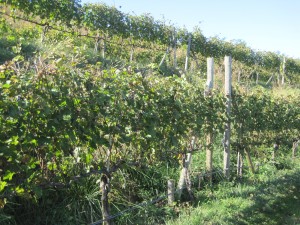
- Slopes are good for vineyards, but this is almost too much. Try getting your tractor across it without tipping.
I can attest to that. Before buying our Nelson County home, we looked at something on the order of 45 properties. Initially we set our parameters at five acres or more, preferably 10. We excluded properties that were wooded (“private” in real-estate speak), and those that were at too low an elevation to provide safety from winter freezes. We wanted slope, we wanted an eastern aspect, we wanted land that was so infertile that a farmer would turn his nose up at it. (Bad soil is ideal for wine grape production, but that’s a story for another post.)
And in the end, we bought a property that was only three acres, with a western aspect and tall trees on the eastern border that would limit sunlight in the morning. So what in the name of all that’s holy were we thinking?
Well, this is the home we plan to retire to in a few years, and we pretty much just fell in love with it. It’s a great house with beautiful mountain views. And it does have a few things going for it as a vineyard property: slope (almost too much slope), really crappy soil, good drainage, and a small section at the western end that we believe will get sufficient sunlight for grape production. Continue Reading–>
Bringing in the Grapes — Part V
Readers of ProjectSunlight have noted a recurring theme over the past month. The weather, at least insofar as vineyard mangers in Virginia are concerned, really sucked this year.
It may be small comfort to the Commonwealth’s vignerons, but the weather has generally sucked worldwide. Jancis Robinson, in her Financial Times column last weekend, detailed the carnage in California and Europe, and even in the Southern Hemisphere, where the growing season is reversed.
“If Europe’s vintners have found 2011 much more trying than any other recent vintage, six months earlier, while picking their 2011s, the Australians experienced the vintage from hell,” she wrote. “Harvest time in the supposedly sunny wine state of South Australia was sodden. Winemakers have had to work extremely hard in some areas to fashion drinkable wine out of bloated, rotten grapes.”
And it goes beyond Australia. “The vintage in New Zealand was bloated too, thanks to frenzied recent planting of vines there, fuelled by a belief that the world is in love with Kiwi Sauvignon Blanc,” she added. “Argentine growers were also afflicted by rain at harvest time in 2011, as well as the usual hail, and unusually late frost in November last year.”
So, weather-related problems span the globe. As I’ve noted before, that’s the way it is with agriculture. You really have no control over the weather, although you can compensate to some extent – to a great extent in normal years, less so in years like 2011 – with a disciplined spraying program.
And winemakers can exert some magic of their own once the grapes come in. This year will be difficult for sure, and none of the winemakers I’ve spoken to have any illusions about the challenges ahead of them. This vintage will definitely separate the men from the boys, so to speak, and show, as Ms. Robinson said, “who exactly are those master craftsmen.”
Bringing in the Grapes – IV
The harvest is so full of unknowns. You never know exactly when the grapes will ripen – when the pH, Brix, tannins, flavor, and so many other variables will all be perfect – and so vineyard managers study the vines each day as
the growing season nears the end, squeezing juice from a random selection of grapes onto the refractometer, checking the seeds, examining the skins, measuring the pH, tasting the juice, and no doubt thinking, “Why me, God – why do You make me suffer each fall?”
But of course, that’s what makes viticulture the wonder that it is. Each season is different. So much work goes into growing the grapes and then so much judgment and so much hope goes into the decision about when to harvest.
Without a doubt, this has been the most difficult growing season in memory in Virginia. It’s hard enough to fathom out the date when the grapes will achieve the perfect balance of sugar and acid, without the additional complication that comes from weather. Consider this: If the grapes will be perfect on Wednesday, but it rains on Tuesday, then you probably would have been much better off picking on Monday, when they were a few days shy of perfection.
And here’s another twist: if it rains on Sunday and Monday, and the grapes swell from the
precipitation, you might think it wise to wait until Thursday or Friday to give them a chance to recover. If the sun comes out and stays out, you will think yourself a genius. But if it rains again, you may curse your stupidity.
Rain causes so much trouble at harvest. The grapes swell and split, bees attack, and the vineyard is ravaged by sour rot and botrytis. Botrytis is a problem, but it can be dealt with in the winery. Sour rot is different. You can see it and smell it, a sour vinegary odor that is apparent in the juice that breaks out of the berries and covers your hands. It’s best to let those grapes fall to the ground.
Every year brings something new, and this year when we arrived at DuCard Vineyards to pick Cab Franc, it was unseasonably cold. The thermometer read 47 degrees when we woke, and didn’t get above 50 until 8 a.m. At that temperature, it would be hard to get the grapes to begin fermenting, so we waited until 10 a.m., after the morning had warmed up just a bit, to start picking.
And what a glorious day it turned into!
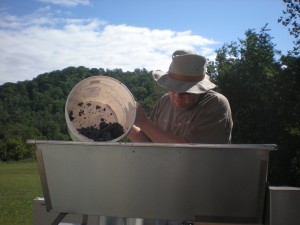
Here's the difference between a good harvest and a bad one -- how you pour the grapes into the crusher. 🙂
As Scott Elliff, owner of DuCard Vineyards said on a recent Saturday, this is what we’ve been working toward all year! This is the harvest – this is the fun part!
He was right. It was like a celebration. We (the Vineyard Goddess and me) spent that day at DuCard picking Cab Franc grapes with a dozen of our friends from viticultural classes at Piedmont Virginia Community College. And while it was work, it was also joyous fun. Continue Reading–>
Bringing in the Grapes – Part III
I received a note today from Kirsty Harmon, winemaker and general manager at Blenheim Vineyards, and I thought I would draw from it to add a little bit to my last post. Kirsty was kind enough to take time out from this most difficult harvest to talk with our class, even though we had barely harvested as much, between the entire group, as a single member of a field crew would have picked in, oh, maybe 15 minutes? Remember, I did say in Part II
that we spent a lot of time staring at the vines, wanting to be sure that we didn’t add bad fruit to the lugs or leave good fruit on the ground.
In any event, we were working on half a section of Viognier that day. Kirsty had told us that they picked the first half a week earlier, due to advanced ripening at the top of the hill and indications that sour rot was starting to set in. Since it was clear that rain was on the way, Blenheim picked the first section which had ripened early, and let the rest hang on in the hope that it would continue to gain sugar and flavor.
The two types of rots that appeared on the grapes in the second section – Botrytis and sour rot – both make grapes mushy (both leak juice with a vinegary odor), and so by the time they would have made it back to the sorting table, they would have leaked all over he good fruit.
“Field sorting is labor intensive, but worthwhile,” Kirsty said. “I would say that many
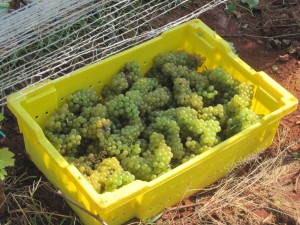
- We weren't very fast, but the fruit we added to the lugs sure looked good! Can't wait to taast the wine. 2011 Viognier.
wineries do take the time to do it though. Lots of wineries pick into bins rather than lugs, and not all wineries have the ability to sort when the fruit is picked into the half ton bins.”
You can see from the pictures in my last post how small lugs are. They are meant to bring grapes back to the crush pad or sorting table in good condition, without the weight of too many clusters at the top crushing those on the bottom.
Blenhein has almost completed its harvest. It has a small amount of Cab Franc remaining to be picked at the vineyard, and a few varieties in the Shenandoah Valley vineyards that it sources grapes from. You can bet that every winemaker and every vineyard manager will be glad to have all their fruit off the vine and into the fermentation tanks. It’s been that kind of year.
“This vintage has been the most challenging one of my career in Virginia,” said Kirsty. I think that almost every vineyard in the Commonwealth – and probably a good many in California as well – would agree.
Bringing in the Grapes – Part II
Since we don’t have grapes of our own to harvest this year, we did the next best thing, and took a class at Piedmont Virginia Community College on “Harvesting and Basic Analysis of the Must,” taught by the incomparable Gabriele Rausse.
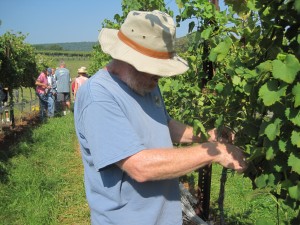
- Each grape is precious – I don’t want to send bad fruit to the crush pad, but I don’t want to waste good fruit either.
After a brief classroom lecture, we moved on to Blenheim Vineyards, where we helped (help being a relative term) pick one section of Viognier grapes. I went into this assuming that picking grapes might be the one thing about viticulture that would be so straightforward, so foolproof – SO SIMPLE! – that we could just do it, without staring at the vines, paralyzed with fear, before asking for help.
Well, no such luck.
For this particular section of the vineyard, Blenheim was “sorting in the vineyard,” which is to say, we were dropping grapes that had succumbed to disease or sour rot, or were otherwise not suitable for pressing. Most often, you bring the grapes in and sort at the crushpad, separating out the fruit that doesn’t belong in the must, and getting rid of MOG – matter other than grapes. (You’d be surprised at how many spiders make their way to the crushpad. )
This has been an exceptionally difficult year for Virginia vineyards, and Blenheim didn’t want to take a chance on letting bad fruit infect the good back at the winery. So, in addition to sorting at the crushpad, Blenheim left bad fruit on the ground in the vineyard. Continue Reading–>

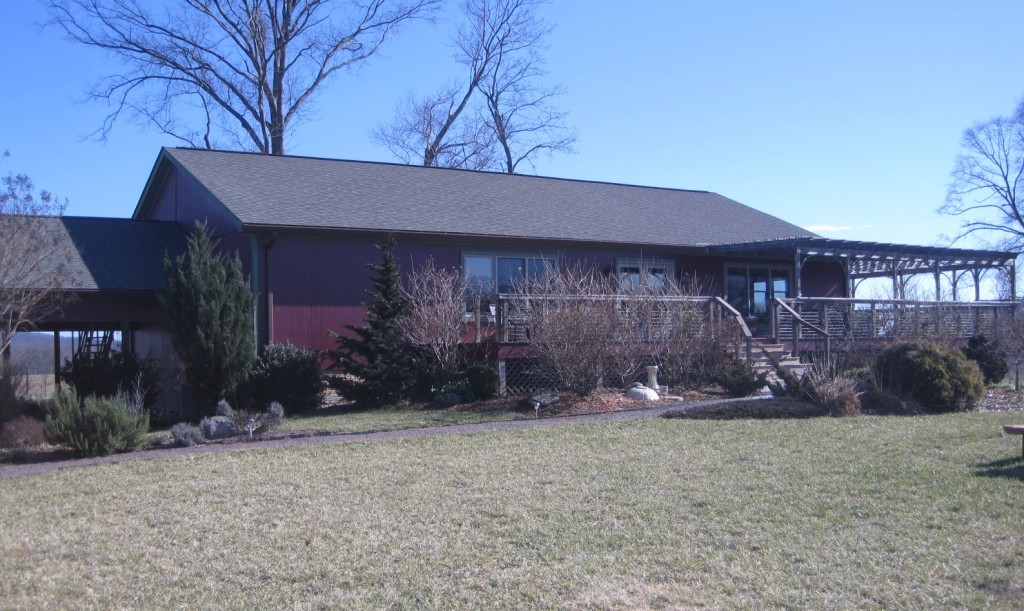
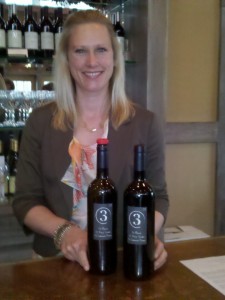
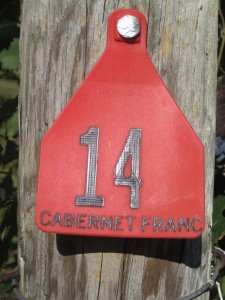
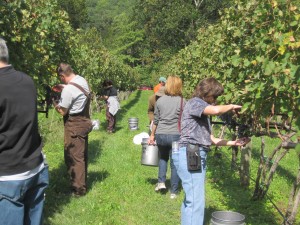
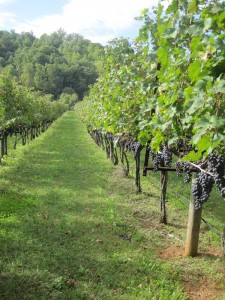
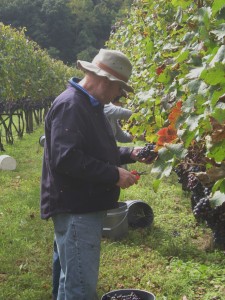
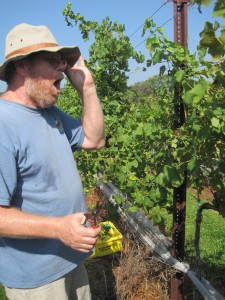

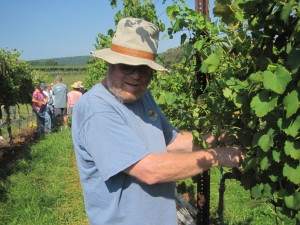
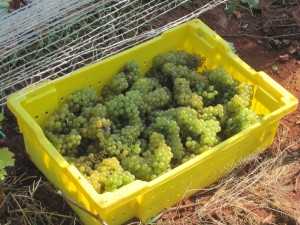


Recent Comments